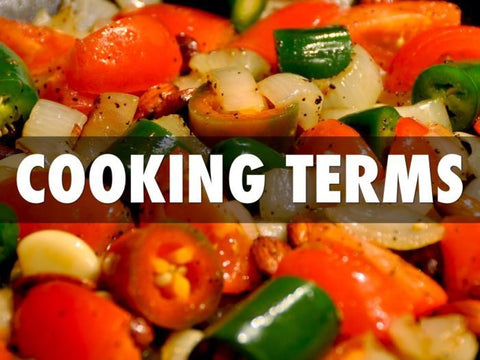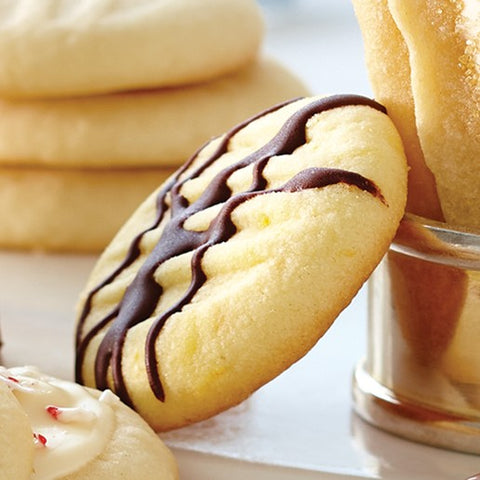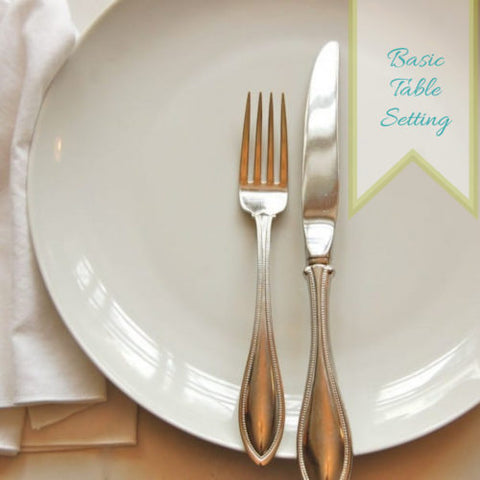Ready to start cooking? Learn to decode common cooking terms and ensure that recipes turn out right, time after time.
1. Slice, Dice, Chop, Mince
Your first challenge comes before you even start cooking: learning how to prepare ingredients. A recipe has two basic components: the ingredients list and the step-by-step instructions. The ingredients not only tell you what to include but also how to prepare it. Don’t know the difference between a slice, dice, chop, or mince?
Slice refers to cutting large ingredients into similarly shaped, flat pieces. (Picture slices of bread, onion rings, carrot coins.) Slices can be thin or thick, and the recipe will direct you accordingly (i.e., thinly slice, slice into 1/2-inch rounds). For example, onion slices should be thinner for a burger (you don’t want a big mouthful of onion), and thicker for grilling or frying.
Chop has to be the most popular direction. It’s the most generic way to say “cut food into smaller pieces.” Like a slice, a chop doesn’t refer to any particular shape or size. When you see chop in a recipe for vegetables or proteins, you can assume they mean similarly sized, squarish pieces between 1/2-inch and 3/4-inch. When referring to herbs like parsley, chop is often modified as roughly chop or finely chop to indicate whether the pieces should be large or super small.
Dice means to cut ingredients into square-shaped pieces that are smaller and more precise than a chop. The goal is to make beautiful, same-sized shapes that will look nice in a salad or will cook evenly when sauteed. Sometimes a recipe will specify the size: a small dice means 1/8-inch, medium dice is 1/4-inch, and large dice refers to 1/2-inch pieces.
Mince is the smallest cut. These pieces should be as small as you can make them. Their tininess means they don’t have to be uniform. Oftentimes, you can use a back-and-forth rocking motion with your knife instead of making precise cuts. Garlic and herbs are often minced.
2. A Dash, a Pinch, a Smidgen, and Seasoning to Taste
Recipes can guide you, but they often leave the final seasoning up to you, as everyone’s taste is different. A cup and a tablespoon are pretty self-explanatory, especially once you know how to measure ingredients, but what about those vaguer terms?
A dash is approximately 1/8 teaspoon.
A pinch is even smaller, about 1/16 teaspoon.
A smidgen is so small it’s not even worth talking about (1/32 teaspoon), but you might see if from time to time. It’s often used when you want a haunting note of the flavor, like nutmeg in a savory dish.
Generally, these measurements happen with the fingers. Start adding a pinch of salt from a bowl, and you’ll quickly get the hang of it.
Seasoning to taste almost always refers to salt and pepper and it is exactly what it sounds like, it’s up to you. If you like it spicy, bring on the freshly ground black pepper. Always start sparingly with salt and taste: you can add more. Above all, don’t stress about this instruction! Just add seasoning as you go till it tastes good.
3. Roast, Bake, and Broil
Dry heat cooking uses air, or fat, to transfer heat to the ingredient (as opposed to using moisture). Roasting, baking, and broiling are the most common oven-based dry heat cooking terms.
Roast and bake are actually the same thing. If you preheat your oven to 375 degrees, for example, the air in the oven heats up to that temperature. The heated air then surrounds the baking dish or roasting pan on all sides and remains constant, cooking your food at an even rate. It is usually called baking when it refers to cooking desserts, breads, or pastries, and roasting when it refers to meats (like roast chicken) or vegetables.
Broil is similar to bake except the food is directly exposed to very high heat on one side only-the top side. It’s like a grill in reverse. In most restaurants, the grill is actually called the broil station. Broiling is commonly used to melt cheese on top of a casserole to achieve that golden-brown look, but you can also cook whole fish or char vegetables using this method.
4. Saute, Sear, Brown, Char
These cooking techniques are more dry-heat cooking methods, and they all have the same basic principle: quickly invoke the Maillard reaction. What the heck is that? Just a chemical reaction that browns food and gives the exterior a distinct flavor. The difference between a good breakfast potato and a great one is that crispy brown exterior. That’s the Maillard reaction at work.
Saute means cooking food quickly over high heat, usually using oil or fat as the cooking medium. It literally means “to jump” in French, referring to the constant motion of food in the pan either by stirring or shaking. The food is lightly browned and cook through during this process. Remember those uniformly diced vegetables we made earlier? It’s important that they’re the same size so they cook at the same rate when cooking via saute.
Sear is an important skill to learn, both for meat and vegetable cookery. Searing cooks an ingredient over very high heat for a brief period of time. Unlike sauteing, the food is not moved until it has become fully browned. Searing seals in the flavor and gives your food a deliciously crusty exterior and a moist, tender interior.
Brown is generally interchangeable with sear. When searing, it’s important to cook in small batches. Overcrowding the pan causes the temperature to drop, preventing a good crust and steaming your ingredients instead of searing them.
Char is similar to sear, except it takes everything to the next level. Charred food is not burnt, but it is almost burnt. Think about charred peppers for making chiles rellenos. You can char by exposing the ingredient directly to a flame underneath a broiler, or you can place it in a very hot pan or on a grill grate. Once the food bubbles and blackens, it is charred. If it smells burnt or tastes bitter, you have gone too far!
5. Deep Fry and Pan Fry
Believe it or not, frying is actually a dry-heat cooking technique: no water is used in the cooking process. Have you ever dropped water onto a pan full of hot oil? It spits at you because oil and water do not mix.
Most recipes will instruct you to fully dry the ingredient before cooking it via one of these methods. This minimizes the chance that water will transfer from the ingredient onto the oil. You may want to dredge the ingredient first, coating it in something dry like flour or breadcrumbs, to provide a protective coating. This not only protects the meat or veggie skin, but it also crisps up nicely.
Deep fry means fully submerging your ingredient in hot oil. Since it is completely submerged, the ingredient cooks on all sides and gets a fantastically crisp exterior. You want it to cook just through to the inside, so the interior stays moist and tender. You don’t need a fancy fryer to do this: it’s actually pretty easy to deep fry at home.
Pan fry uses much less oil than deep frying but more oil than a typical saute. The recipe will usually specify the amount of oil (i.e., heat 1-inch of oil), but a general rule of thumb is the oil should come halfway up the side of the ingredient. This method is great for delicate items that may fall apart in the deep fryer, like crab cakes or zucchini fritters.
6. Braise
Braise stands in a category of its own. It’s a combination cooking method that uses dry cooking techniques in the beginning to brown the meat followed by moist cooking methods to finish cooking it in liquid. Braising almost always refers to cooking something low and slow to tenderize tough cuts and well-worked muscle proteins.
If you’re not braising, then you’re losing out on an opportunity to impress your dinner guests. Seriously. People can’t resist the tender cuts of meat in chili, a shredded pork shoulder, or fall-off-the-bone lamb shanks. Inexpensive cuts of meat transform into something totally amazing when braised.
Stew is really another kind of braising. When cooking large cuts of meat (like that pork shoulder), it’s called braising. When you cut the meat into smaller pieces and completely submerge them in the liquid (like pork green chile stew), it’s called stewing.
7. Boil, Simmer, Poach, Steam, Blanch (and Something About an Ice Bath?)
All of these cooking terms involve cooking with water, so they’re known as moist cooking methods.
Boiling brings water to a temperature of 212 degrees at sea level. The water is in full motion with bubbles rising rapidly (and noisily) to the surface. Boiling is a common cooking technique for pasta. Many recipes will instruct you to bring water to a boil and reduce it to a simmer. Boiling is also essential for steaming and blanching.
Simmering refers to cooking in a liquid that is just below the boiling point, between 180 and 205 degrees. You should see bubbles forming, but they should be gentle and not at a full roll. Simmering is the most common moist cooking method, used for everything from simmering stocks and soups to cooking vegetables.
Poaching falls in the temperature range between 140 and 180 degrees. There should be few to no bubbles in the water, although the water should gently ripple to maintain its heat. This method is perfect for cooking delicate foods, like fish and eggs, that would be disturbed or destroyed by aggressive bubbles.
Steaming uses boiling water, although the ingredients never touch the water itself. By placing a steamer basket above boiling water, the ingredient cooks at 212 degrees without losing any of its flavors to the water. Tamales are a perfect example of a steamed dish, although steaming is also used for cooking vegetables and fish.
Blanching also involves boiling water and is well known for setting the color of a vegetable. The ingredient is plunged into boiling water for a brief time before being removed to an ice bath. This process brings out a vibrant, bright color without cooking the vegetable all the way through. The result is a tender-crisp vegetable. Delicious!
- What’s an ice bath? A large bowl filled with water and ice. Dropping the food in here immediately halts the cooking process, preserving bright color and optimal texture of ingredients, from peas to hard-boiled eggs.
From – Taste of Home



